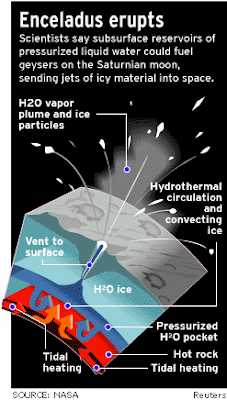Astrobiology / Exobiology.
12/03/2011
Europe, Enceladus - The index of habitability (in Russian)
Life beyond Earth is - believe astrobiologists. Moreover, to find its primitive forms to fly away is not necessary. Discoveries of recent years have shown that the oceans are not only water on our planet. Jupiter - Europe - one of the main contenders for habitability. Scientists believe that under the ice cap in Europe is possible biological life.
Europe - Moon of Jupiter (Credit: NASA)
Discoveries of recent years show the oceans of water is not only on our planet. And where the water is, there is life.
Its surface is covered by 100 km long sheet of ice. According to specialists, it was under this ice cap, and there is water.
Vladimir Surdin, senior fellow SAI them. Sternberg: "The evidence as to why Europe can be water, currents, etc. Now no one doubts that there may be water ... "
Ice Sheet Fracturing on Europe, Moon of Jupiter (Artist view by Donato Giancola)
True, the conditions for life on Europa extremes: ice thickness under enormous pressure, there does not get sunlight. One may wonder about what life is all about?
Samples of ice were brought to MSU from Antarctica. 2 million years, these microbes isolated from the outside world, living on half a kilometer deep, at a temperature of minus 20 degrees. They not only survived, but were able to proliferate.
Elena Vorobyov, Senior Researcher, Department of Soil Science, "Life as we know it - this protein life, the concept of stability of life forms, is changed, this is what happened in the last 20 years of research. It was found that on Earth a lot of extreme places in which organisms not only survive, but still functioning in general ... There is resistant to radiation ... "
Image above: Thick or thin ice shell on Jupiter's moon Europe? Scientists are all but certain that Europa has an ocean underneath its surface ice, but do not know how thick this ice might be. This artists' conception illustrates two possible cut-away views through Europe's ice shell. (Credit: NASA / JPL, Artwork by Michael Carroll).
Years of research in the Arctic and Antarctica have shown that even there, at great depths is life.
Elena Vorobyov, Senior Researcher, Department of Soil Science continues: "Now we know that organisms could have arisen without organic matter. Anaerobic organisms that do not require oxygen. They take the energy from chemical reactions, a compound of iron and gas components: hydrogen, carbon dioxide. This is enough to micro-organisms could exist. "
Enceladus - Moon of Saturn (Credit: NASA)
The second candidate on the habitability of Saturn - Enceladus. It has a diameter of 500 kilometers. As well as Europe, it is covered with ice. Moreover, it is a huge crack from which water fountains beat the high tens of kilometers.
Vladimir Surdin, senior fellow SAI them. Sternberg: "The little moon Enceladus is named. It rotates around Saturn, nobody had paid any attention to it, a lot of these satellites. Jupiter 60, Saturn 60 ... recently discovered an amazing thing, under the icy surface of Enceladus, too, there is an ocean, but if Europe should drill, then Enceladus is not necessary, just fly up and take samples of water ... is not that hard ... "
Enceladus Ice Plumes (Artist view by Michael Caroll)
To find the primitive forms of life outside Earth, fly away do not. Almost every planet with its satellite repeats in miniature solar system. The farther away the satellite from the planet, the probability of habitat is reduced.
Enceladus Ice Plumes (Credit: NASA)
The convenient location, in the so-called zone of life, which was once Earth, Europa, Enceladus, has allowed them to keep water in liquid form, and hence the possibility of biological life.
Original text in Russian: http://www.federalspace.ru/main.php?id=2&nid=18374
Images, Video, Text, Credits: Roscosmos PAO / Studio Roscosmos / Roscosmos TV / NASA / Donato Giancola / Michael Caroll / Reuters / Translation: Orbiter.ch.
Greetings, Orbiter.ch


















































